- Home
- Types of Sailboats
- Cruising Catamaran
Understanding Cruising Catamarans: A Comprehensive Sailor's Guide
In a Nutshell
A catamaran can be an excellent choice for cruising, offering unparalleled space, stability, and comfort. While their wide beam and shallow draft make them ideal for exploring island-filled regions like the Caribbean, they can incur higher marina fees and may not perform as well as a monohull when sailing into a headwind. With a focus on owner-version designs and proper maintenance, a catamaran provides a fast, stable, and highly liveable platform for long-term cruising.
 An Apache 41 cruising Catamaran
An Apache 41 cruising CatamaranTable of Contents
- Cruising Catamarans: What are the Advantages & Disadvantages?
- Catamaran Accommodation & Onboard Living: How Do They Compare?
- What are the Sailing & Maneuvering Characteristics of a Catamaran?
- Anchoring & Mooring a Catamaran: What are the Key Considerations?
- What are the Critical Safety & Maintenance Checks for Cruising Cats?
- Beyond the Purchase Price: What are the Practical Costs & Logistics?
- What are the Latest Design & Technology Trends?
- Frequently Asked Questions
Cruising Catamarans: What are the Advantages & Disadvantages?
For decades, there has been a lively debate among sailors: one hull or two? For those considering an extended voyage, the decision between a traditional monohull and a twin-hulled catamaran is a pivotal one, with each offering a distinct cruising experience. While a catamaran offers more living space and a flatter ride, a monohull provides a more traditional sailing feel and can be less expensive.
Here’s a comparison of the key differences to consider:
| Feature | Catamaran | Monohull |
|---|---|---|
| Stability & Motion | Minimal heeling (flat ride), reducing seasickness. Quick, unpredictable motion in choppy seas. | Significant heeling (up to 30 degrees), which can be uncomfortable for some. Rhythmic, predictable motion. |
| Speed & Performance | Generally faster overall, especially off the wind. Slower upwind due to windage & shallow draft. | Generally faster upwind, can cut through waves. Slower on downwind courses. |
| Space & Comfort | Much more living space, with separate cabins in each hull, a large saloon, and generous deck space. | Less living space below deck. Cabins are often smaller with shared spaces. |
| Cost | Higher initial purchase price and maintenance costs (two engines, two rudders). Marina fees can be double. | Lower initial price and maintenance costs. Can fit into standard marina slips. |
| Maneuverability | Exceptional maneuverability in tight spaces using twin engines. Wide beam can be a challenge in crowded marinas. | Good maneuverability under power but requires more skill in tight spaces. Easier to dock in narrow slips. |
Catamaran Accommodation & Onboard Living: How Do They Compare?
With accommodation in both hulls and the central structure, a catamaran sailboat has ample space below to make a good cruising home. Three separate cabins, each with a double berth, is the norm in a 38-foot catamaran designed for chartering. Unlike a monohull, these double berths stay reasonably flat and level when underway, so individual seaberths with lee cloths are not necessary—a great comfort for cruising families or couples.
For long-term liveaboard cruisers, provisions like cross-ventilation, ample storage for food and water, and even modifications for specific climates are critical. A well-designed owner-version catamaran can cater beautifully to these needs, as it prioritizes liveability and functionality over sheer capacity. For example, the Lagoon 400 S2 offers a spacious owner's cabin that takes up the entire starboard hull, providing a private head & shower, a desk, and plenty of storage—a feature rarely seen in a monohull of similar length.
It’s worth noting that trimarans sacrifice accommodation for performance. While they’re less spacious, the thrill of sailing a high-performance trimaran might appeal to cruisers prioritizing speed & exhilaration.
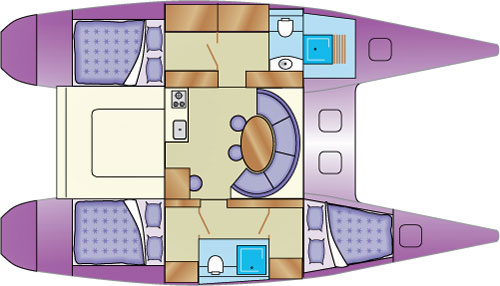 Spacious accommodation of a typical 40' catamaran
Spacious accommodation of a typical 40' catamaranWhat are the Sailing & Maneuvering Characteristics of a Catamaran?
One common critique of catamarans is their reputation as poor windward performers, especially when reefed in heavy weather. This is largely due to their high windage & shallow draft. While most have vestigial keels to resist leeway, performance-oriented models fitted with daggerboards stand out for their improved upwind capabilities.
Overloading a catamaran will, as with all light-displacement sailboats, decrease the Sail-Area/Displacement Ratio and spoil performance. As an experienced ocean sailor, in my opinion, long-distance cruising catamarans only begin to make sense at around 45 feet. Smaller, high-volume cats, when loaded with the equipment for offshore cruising, can become, well, "dogs."
At sea, a catamaran's inability to absorb the small variations in the wind by heeling gives them a peculiar, lurching movement which can be a bit disconcerting until you get used to it. The rapid variations in speed & the effects these have on the apparent wind direction also mean that wind vane self-steering systems find it very difficult to keep a multihull on a straight course. An electronic autopilot is almost a necessity for any long-distance sailing.
But a properly designed catamaran from the board of a designer unconstrained by the requirements of the charter market can make a fine cruising boat. Under power, a catamaran's maneuverability can be remarkable. If they have an engine in each hull, putting one astern & the other ahead will turn a catamaran in its own length with ease—a redeeming feature in a marina, where you are likely to attract a hefty surcharge for a berth.
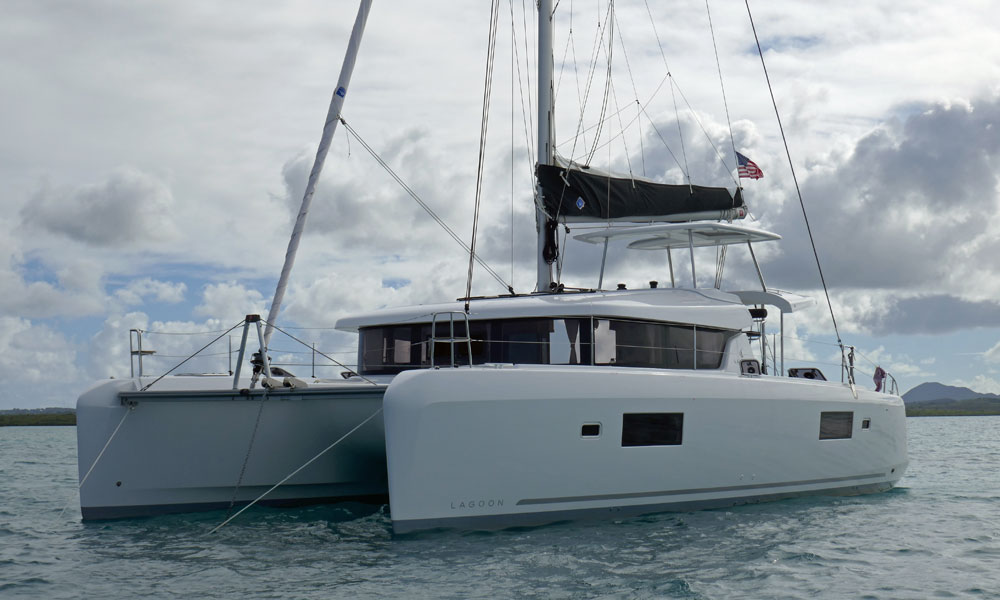 Designed with the charter market in mind, a Lagoon 42 catamaran
Designed with the charter market in mind, a Lagoon 42 catamaranAnchoring & Mooring a Catamaran: What are the Key Considerations?
A catamaran at anchor is prone to swinging and yawing, a characteristic not universally applauded by monohull cruisers anchored nearby. This cavorting at anchor is a result of the catamaran’s:
- high windage;
- light displacement; and
- shallow draft.
However, this can be much reduced by using an anchoring bridle. The bridle is attached to the anchor chain by a grab hook and secured to each of the hulls at an adequately engineered pad eye. Most skippers leave the bridle permanently fitted to the hulls, ready for deployment at the next anchorage.
In the Caribbean, for example, where they are very popular, safe leeward anchorages abound—so there's little reason to tie up in expensive marinas. In other parts of the world where safe anchorages are not so easy to find, mooring your catamaran in a marina can be pretty expensive. Expect to pay double what you'd pay for a monohull of similar length overall.
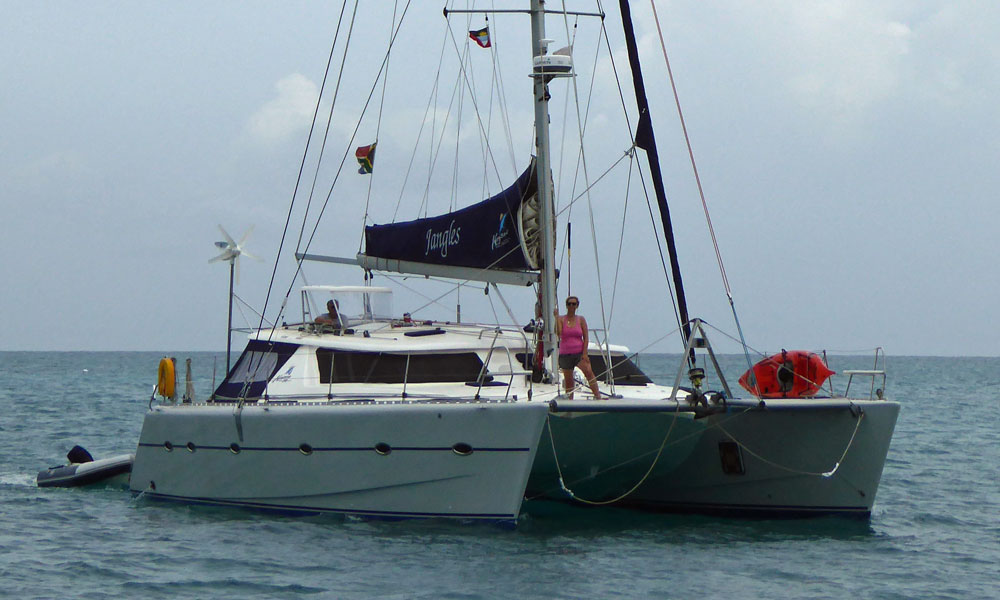 This Knysa 480 cruising catamaran has its anchoring bridle ready to deploy
This Knysa 480 cruising catamaran has its anchoring bridle ready to deployWhat are the Critical Safety & Maintenance Checks for Cruising Cats?
The safety of a catamaran hinges on proactive maintenance and smart sailing. Given their design, there are specific areas that require extra vigilance. In my experience as an RYA 'Offshore Yachtmaster', a well-prepared crew and a well-maintained boat are a crew's best assets. This is especially true on a catamaran, where systems are duplicated and maintenance tasks are more numerous.
Safety Checks:
- Man Overboard (MOB) Drills: Because of a catamaran’s wide beam and minimal heel, approaching a casualty can be difficult. It’s critical to practice picking up a person from the water from a position downwind of the casualty to avoid entanglement with the propellers.
- Bridgedeck Slamming: On many production multihulls, the bridgedeck is set low to maximize standing headroom. This can lead to noise and slamming from waves, which can be disconcerting and potentially damaging during a long passage.
- Capsize Risk: While rare in modern cruising designs, capsize is a real consideration in extreme conditions. The biggest risk is being caught on a beam sea or running off too fast downwind in breaking waves. Proper seamanship and early reefing are essential.
- Redundancy: The dual-engine and dual-rudder setup provides a built-in safety factor. If one system fails, you still have a backup, which is a major advantage over a single-engine monohull.
Key Maintenance Points:
- Engine & Systems: With two engines, two rudders, and often two heads, maintenance is a more extensive affair. You must be diligent about regular oil changes, impeller checks, and inspecting all through-hull fittings.
- Bilge Checks: Catamarans have multiple bilge zones, one in each hull. You need to check each bilge pump regularly to ensure float switches are working and the discharge hoses are not blocked.
- Rigging & Sails: Due to a catamaran's minimal heel, the rig is under constant load. It's vital to regularly inspect all rigging for signs of failure, corrosion, or broken strands.
- Weight Management: Overloading a catamaran significantly affects its performance and can compromise safety. Weight should be carefully and evenly distributed.
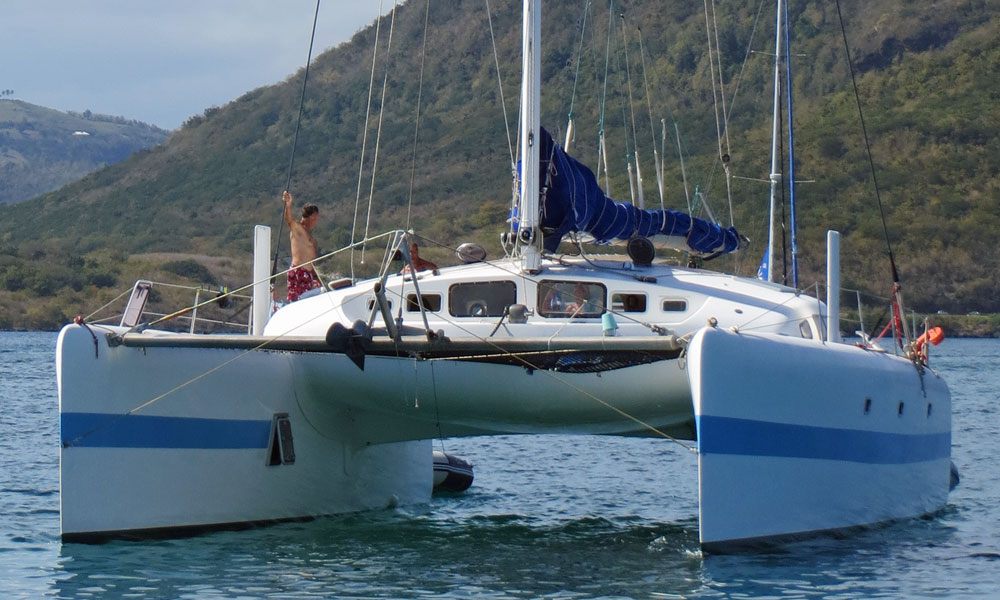 The high bridgedeck on this cruising catamaran will reduce slamming to a minimum
The high bridgedeck on this cruising catamaran will reduce slamming to a minimumBeyond the Purchase Price: What are the Practical Costs & Logistics?
While the initial purchase and marina fees are significant, an experienced sailor knows that the total cost of ownership is far more than just what you pay at the dock. For a catamaran, there are a number of ongoing, practical expenses and logistical challenges that require careful planning.
Total Cost of Ownership
Catamaran insurance is often more expensive due to the higher replacement value and the increased risk in certain situations. Haul-out costs can also be substantially higher. Because of their wide beam, catamarans can't use standard travel lifts at most boatyards. Finding a yard with a large enough lift—or one that uses a hydraulic trailer—can be a logistical hurdle that comes with a premium price.
Onboard Systems & Spares Management
The mantra for long-distance cruising is "two is one, and one is none." This is particularly true on a multihull with redundant systems. It’s crucial to treat each engine, each prop, and each set of rigging as a separate maintenance item. Your spares inventory needs to reflect this duplication. For every part you'd carry on a monohull—from an impeller or alternator to fuel filters and head gaskets—you'll need a spare for each side.
Sail Plan & Rigging Optimisation
A catamaran's rig is constantly under load, as the boat doesn't heel to spill wind from the sails. This makes robust rigging and a versatile sail inventory non-negotiable. While the jib and mainsail will handle most sailing, performance-oriented catamarans often carry additional light-air sails. A screacher or Code Zero is essential for getting the most speed out of your boat in lighter conditions. This directly links to your other content on sailboat sails and establishes a clear expertise in this area.
For more on the cost aspect you may want to take a look at oue aericle 'the true cost of boat ownership'—or maybe not...
What are the Latest Design & Technology Trends?
Modern cruising catamaran design is moving beyond just space and stability. New trends focus on performance, sustainability, and hybrid living. While the core features remain, manufacturers are using cutting-edge techniques to deliver an even better cruising experience. A good example is the Seawind 1370, with its modern reverse bows and immersed hull shapes that are intended to combine high performance with good load-carrying capacity.
Here are some of the trends we’re seeing in new cruising catamarans:
- Lightweight Composites: The use of carbon fiber and other advanced composite materials is creating lighter, stiffer hulls. This leads to better performance and the ability to build larger boats without compromising stability or speed.
- Hybrid & Electric Propulsion: With large deck areas perfect for solar panels, catamarans are well-suited for electric and hybrid propulsion systems. This reduces dependence on noisy diesel generators, enhances the sailing experience, and is more environmentally friendly.
- Indoor & Outdoor Integration: Designers are moving away from traditional, separate saloon and cockpit spaces. The trend is to merge these areas with large, opening glass doors that create a single, spacious indoor/outdoor living area.
- Wave-Piercing Bows: These aggressive, reversed bows are designed to cut through waves, increasing performance and reducing pitching or "hobby horsing," providing a more comfortable ride.
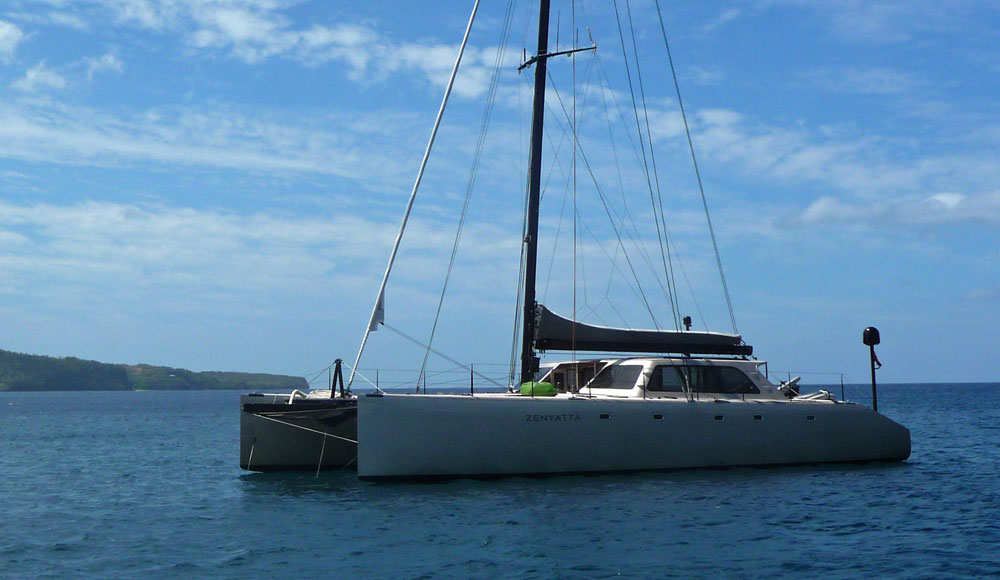 A Gunboat 63 performance cruising catamaran
A Gunboat 63 performance cruising catamaranSo that's cruising catamarans pretty much covered, but you can read about the other types of cruising sailboats in our aricle The Ultimate Guide to Sailboats & Rigs: Sloops, Ketches & More.
This article was written by Dick McClary, RYA Yachtmaster and author of the RYA publications 'Offshore Sailing' and 'Fishing Afloat', member of The Yachting Journalists Association (YJA), and erstwhile member of the Ocean Cruising Club (OCC).
Frequently Asked Questions
Are catamarans more expensive to own?
Are catamarans more expensive to own?
Yes, generally. They have a higher initial purchase price and maintenance costs due to having two engines and more systems. Marina fees can also be double that of a monohull of the same length.
Can a catamaran be single-handed?
Can a catamaran be single-handed?
Modern, larger catamarans (e.g., 45-50ft) can be sailed by a short-handed crew due to the use of electric winches, furling systems, and reliable autopilots. However, they require careful planning and a good knowledge of the boat.
Are catamarans safe in bad weather?
Are catamarans safe in bad weather?
A well-designed cruising catamaran is very safe in heavy weather, provided it is sailed with proper seamanship. While they do not sink like a monohull, a capsize in extreme conditions is a possibility, though a rare one.
Sources used to draft this article:
- Gilles Reigner, Catamaran Safety Drills: Being Prepared for the Unexpected. https://gillesreigner.com/catamaran-safety-drills/
- Yachting World, Catamaran sailing part 7: capsize. https://www.yachtingworld.com/catamaran-sailing/catamaran-sailing-techniques-part-7-worst-happen-nigel-irens-78240
- Yacht-Match, Catamaran Cruising Comparison. https://www.yacht-match.com/catamaran-cruising-comparison-advice-tools-to-aid-your-search/
- Maritime Education, Catamaran vs Monohull: Which Is Better for Your Holiday? https://maritimeducation.com/catamaran-vs-monohull-which-is-better-for-your-holiday/
Recent Articles
-
Passoa 47 Sailboat Review: Comprehensive Specs & Performance Analysis
Jan 04, 26 04:57 AM
Discover the Passoa 47, a legendary aluminium blue water cruiser by Garcia. Explore technical specifications, design ratios, and why its lifting keel is a game-changer for offshore sailors. -
Sailboat Wheel Steering Maintenance & Inspection Checklist
Dec 30, 25 02:32 PM
Keep your vessel’s helm responsive and reliable with our expert maintenance checklist. Master cable tensioning and system inspections to avoid mid-passage failures. -
Modern Boat Electronics and the Latest Marine Instruments
Dec 20, 25 05:27 PM
Should sailboat instruments be linked to the latest boat electronics as a fully integrated system, or is it best to leave them as independent units?












